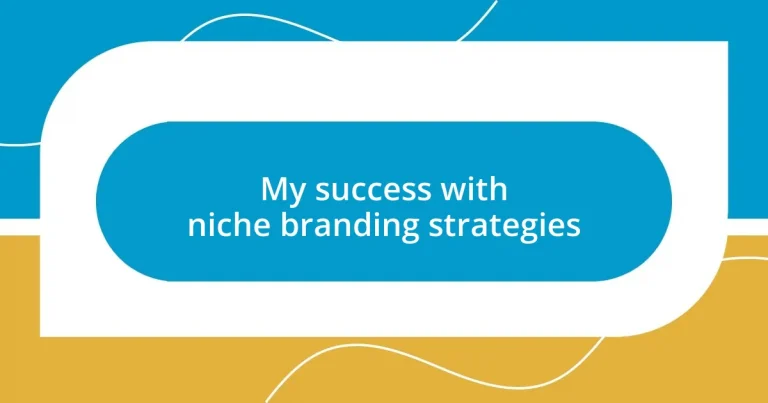Key takeaways:
- Niche branding focuses on creating a unique identity and community by addressing specific customer needs and values.
- Understanding your target audience involves in-depth analysis of demographics, interests, pain points, and buying behavior.
- Identifying market gaps and conducting competitor analysis are crucial for developing products that resonate with consumers’ unmet needs.
- A strong online presence is built on consistency, engaging communication, and the effective use of visual storytelling.

Understanding niche branding
Niche branding is all about carving out a distinct space in a crowded market. I remember when I first decided to focus on a specific audience; it felt like uncovering a hidden treasure. Have you ever found yourself drawn to a unique product that resonated with your interests? That’s the magic of niche branding—it connects deeply with people by addressing their specific needs and desires, almost as if it was made just for them.
When I began to explore niche branding, I discovered that it’s not merely about selling products; it’s about building a community around shared values and passions. As an entrepreneur, I felt a sense of fulfillment when customers engaged with my brand, sharing their experiences and establishing a bond. This engagement doesn’t just create loyalty; it transforms consumers into advocates. Have you experienced that exhilarating moment when you realize your brand has made a genuine impact on someone’s life?
Additionally, understanding niche branding means recognizing the power of authenticity. In my journey, I chose to prioritize transparency and ethical practices, and it resonated with my audience. Have you ever felt truly connected to a brand because of its values? Authenticity fosters trust, inviting consumers to be part of something larger—a movement, perhaps—rather than just a transaction, and that connection can be incredibly powerful.

Identifying your target audience
To truly identify your target audience, I found that diving deep into their preferences and motivations is essential. In my experience, conducting surveys or engaging in social listening revealed insights I never expected. When I started interacting with potential customers on social media, I discovered little things that helped me understand their pain points and what they value most.
Consider these aspects when pinpointing your audience:
- Demographics: Age, gender, income level
- Interests: Hobbies, activities, and pastimes they enjoy
- Pain Points: Challenges they face that your product can solve
- Values: What do they hold dear? Ethical sourcing, sustainability, etc.
- Buying Behavior: How do they shop—online, in-store, or both?
By connecting these dots, I felt a clearer vision of who I was truly serving. It’s like getting to know a friend; the more I listened, the more I understood their unique traits and preferences, which ultimately shaped my branding strategy.

Evaluating market gaps and needs
Evaluating market gaps and needs is a pivotal step in niche branding that I wish I had understood earlier in my journey. When I think back, identifying what potential customers lack in the market can feel like spotting a rare bird in the wild. It requires both analytical skills and intuition. I remember studying competitor offerings and noticing a common pain point that hadn’t been addressed effectively. That insight became a launching pad for me to develop solutions that resonated with that specific audience.
As I delved deeper into evaluation methodologies, I found that approaching this task from multiple angles produced the best results. For instance, performing SWOT analysis—examining strengths, weaknesses, opportunities, and threats—helped me visualize the landscape around my niche. In addition, conducting customer interviews revealed authentic concerns and desires. Have you ever had a conversation that shifted your perspective? I certainly felt that way when consumers shared their frustrations. It sparked ideas I hadn’t considered before, guiding my product development to meet real needs.
To put it simply, understanding these market gaps isn’t just about numbers; it’s about empathy. Reflecting on my own experiences, I now approach product features by first imagining how they fulfill the emotional and functional needs of my audience. I’ve learned that this alignment between consumer desires and offerings can be the key to unlocking brand loyalty and success.
| Aspect | Description |
|---|---|
| Market Gaps | Unmet needs or pain points that consumers express |
| Competitive Analysis | Examining similar offerings to identify gaps |
| SWOT Analysis | Assessing your brand’s strengths, weaknesses, opportunities, and threats |
| Customer Interviews | Gathering feedback to uncover deeper insights |

Creating a unique value proposition
Creating a unique value proposition (UVP) is like crafting a personalized message that resonates deeply with your audience. When I first tackled this task, I felt overwhelmed by the competition. I asked myself, “What makes my brand stand out?” After some soul-searching, I realized that my passion for sustainability was a significant differentiator. By infusing this value into my brand story, I wasn’t just selling a product; I was inviting consumers to join me on a journey toward a greener future.
It’s essential to articulate your unique value in a way that speaks directly to your audience’s heart. For instance, when I revamped my UVP, I focused on the emotional aspects of my products—how they empower consumers to make eco-friendly choices without sacrificing quality. This transformation became more than just a tagline; it turned into a mantra that I infused in every marketing effort. Think about it: does your message echo in a way that inspires action?
Reflecting on my journey, I’ve learned that a compelling UVP requires clarity and authenticity. I remember sitting down with a mentor who guided me through the process. Together, we condensed my brand’s essence into a simple statement that captured both my mission and value. That moment was a game-changer. It felt exhilarating to see how one clear message could unify everything from product design to customer engagement. Don’t underestimate the power of that uniqueness—your UVP can be the beacon that guides your brand to success.

Developing a niche marketing plan
Developing a niche marketing plan starts with identifying your target audience. I remember creating a detailed customer persona that felt almost like creating a character for a novel. It included demographics, interests, and even their pain points. The more specific I got, the clearer my marketing messages became. Have you ever thought about how pinpointing the quirks of your ideal customer can drastically shape your brand’s voice? I certainly have, and it made a world of difference.
Another crucial element in my niche marketing plan was setting clear, measurable goals. Initially, I found myself throwing spaghetti at the wall to see what stuck. But once I decided to use the SMART criteria—specific, measurable, achievable, relevant, and time-bound—things shifted dramatically. My goals became a roadmap rather than a guessing game. For example, rather than aiming to “increase sales,” I set a target to “boost sales by 20% within six months.” This clarity helped me maintain focus and assess my progress effectively.
Lastly, I can’t stress enough the importance of ongoing evaluation and adaptation in your plan. After launching my initial campaigns, I was surprised to see how changing even small elements—like the wording of a call-to-action—could yield substantial results. I began regularly checking analytics and feedback, treating them as vital insight rather than just numbers. It’s like tuning an instrument; small adjustments can lead to a symphony of success. How often do you rethink or refresh your strategies? I found that this continual process keeps my marketing efforts relevant and impactful, much to my delight.

Building a strong online presence
Building a strong online presence is all about consistency and authenticity. In the early days of my brand, I struggled to keep my social media profiles aligned. It felt like I was juggling multiple personas. But when I committed to a unified voice and tone across platforms—whether it was Instagram, Facebook, or my website—everything clicked. Have you ever noticed how brands that speak with one voice can create a sense of community? I certainly did, and it fueled my growth.
Engaging with my audience was another key factor in shaping my online presence. I remember one evening when I decided to host a live Q&A session on Instagram. My heart raced as I awaited questions, but the interaction was invigorating. I felt an immediate connection with my followers, and it was clear that they appreciated the chance to engage. Do you think asking for feedback can open new doors? I found that by incorporating audience insights into my content, I not only strengthened my presence but created a loyal fan base.
Lastly, I learned the impact of visual storytelling. Initially, my posts were text-heavy, and I often overlooked the power of images. Once I started utilizing captivating visuals that represented my brand ethos, engagement rates soared. I recall the thrill of a particular post that featured an eye-catching infographic. It was a game-changer, illustrating my mission in a visually compelling way. How often do you think about the aesthetics of your brand online? For me, integrating visuals turned my digital space from a mere platform into an immersive brand experience.

Measuring success and adjusting strategies
Measuring success in niche branding goes beyond just tracking sales numbers. I remember the first time I analyzed website traffic with a sense of excitement, only to feel deflated when I realized that high visits didn’t directly convert to sales. That experience taught me the value of diving deeper into metrics like conversion rates and customer retention. Have you ever looked at your data and felt overwhelmed? I learned to break it down into digestible segments, looking at specifics like user engagement and feedback, which often revealed the real gems of insight.
Adjusting strategies hinges on understanding these insights. After one campaign flopped, I initiated a brainstorming session with my team, armed with feedback and analytics. We pivoted the messaging and refined our target audience focus. I could almost feel the room shift, as creativity sparked with every new idea. It’s fascinating how adapting can pave the way for renewed enthusiasm. Have you felt that rush when a strategy tweak suddenly resonates more with your audience? In my case, even a slight change like repositioning a product led to surprising results.
Regular check-ins on my marketing plan have been game-changers too. I decided to hold monthly review sessions, which transformed my approach from reactive to proactive. During one of these sessions, I discovered a significant dip in engagement around a certain time of year. It hit me that being mindful of seasonal trends allowed us to tailor our messaging more effectively. How often do you evaluate your strategies? That exercise of reflection and adaptation not only fuels growth but also cultivates an agile mindset, making the whole process feel more organic and less daunting.














